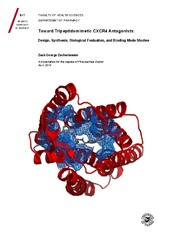Toward Tripeptidomimetic CXCR4 Antagonists: Design, Synthesis, Biological Evaluation, and Binding Mode Studies
Permanent link
https://hdl.handle.net/10037/10059View/
Thesis introduction (PDF)
Zachariassen, Z.G., Thiele, S., Berg, E.A., Rasmussen, P., Fossen T., Rosenkilde, M.M., Våbenø, J., Haug, B.E.: ‘Design, synthesis, and biological evaluation of scaffold‐based tripeptidomimetic antagonists for CXC chemokine receptor 4 (CXCR4)’. Submitted manuscript. Later published in Bioorganic & Medicinal Chemistry (2014), vol 22, no 17, p 4759-4769 (PDF)
Zachariassen, Z.G., Thiele, S., Haug, B.E., Rosenkilde, M.M., and Våbenø, J.: ‘Probing the molecular interactions between C‐X‐C chemokine receptor 4 (CXCR4) and the tripeptidomimetic antagonist KRH‐1636’ (manuscript version). Later published in Journal of Medicinal Chemistry (2015), vol 58, no 20, p 8141-8153 (PDF)
Date
2014-04-11Type
Doctoral thesisDoktorgradsavhandling
Author
Zachariassen, Zack GeorgeAbstract
In order for the HIV virus to take over and destroy human immune cells, which results in AIDS, the virus first has to enter the cells. This takes place by interactions between viral proteins and specific receptors on the surface of our cells. One of these receptors is CXCR4, and it has been shown that chemical compounds that bind to and block the CXCR4 receptor, so-called CXCR4 antagonists, are able to obstruct HIV entry into human cells.
In the present project, the pharmacophore for the lead cyclopentapeptide CXCR4 antagonist FC131 was first refined through structure-activity relationship (SAR) studies of its two aromatic positions. While the D-tyrosine side chain in position 5 was found dispensable, the 2-naphthylalanine side chain in position 3 was shown to be important for the antagonistic activity of the cyclopentapeptide analogues.
Encouraged by this SAR data, which suggest that the activity of cyclopentapeptide CXCR4 antagonists mainly resides in the tripeptide D-/L-Arg-L-Arg-2-Nal fragment, a novel class of scaffold-based tripeptidomimetics were next designed and synthesized. These prototype tripeptidomimetics were found to represent new peptidomimetic hits, and subsequent studies aiming to optimize the prototype compounds have been pursued.
Finally, the binding mode for the known tripeptidic CXCR4 antagonist KRH-1636 was investigated through a ternary strategy combining SAR-, site-directed mutagenesis (SDM) studies, and molecular docking to the X-ray structure of CXCR4. Comparison of the derived binding model for KRH-1636 with the reported binding mode for the cyclopentapeptide antagonist FC131 showed that the two compounds bind to the receptor in different ways; thus, KRH-1636 is not a mimetic of FC131.
Collectively, the findings from the present project provide a foundation for future design of optimized small-molecule peptidomimetic CXCR4 antagonists.
Description
Paper 1 of the thesis is not available in Munin: Mungalpara, J., Zachariassen, Z.G., Thiele, S., Rosenkilde, M.M. and Våbenø, J.: 'Structure‐activity relationship studies of the aromatic positions in cyclopentapeptide CXCR4 antagonists', Org. Biomol. Chem. 2013; 11, 8202‐8208, available at http://dx.doi.org/10.1039/c3ob41941j.
The accepted manuscript version of this article is available in Munin at http://hdl.handle.net/10037/5829
The accepted manuscript version of this article is available in Munin at http://hdl.handle.net/10037/5829
Publisher
UiT The Arctic University of NorwayUiT Norges arktiske universitet
Metadata
Show full item recordCollections
Copyright 2014 The Author(s)
The following license file are associated with this item:
Except where otherwise noted, this item's license is described as Attribution-NonCommercial-ShareAlike 3.0 Unported (CC BY-NC-SA 3.0)
Related items
Showing items related by title, author, creator and subject.
-
A Biofocussed Chemoprospecting Approach to Drug Discovery: Design, Synthesis and Bioactivity Screening of Diverse Biofocussed Chemical Libraries
Thakkar, Balmukund (Doctoral thesis; Doktorgradsavhandling, 2017-04-28)With pharma R & D witnessing rising cost, high attrition rates and an overall decline in productivity in recent times, newer approaches are needed for more efficient early phase drug discovery. This thesis describes a new approach, “biofocussed chemoprospecting”. The essence of the approach is to use diverse, yet “bio-like” compounds for efficient hit-finding, along with property filtering and ... -
Novel [18F]fluorinated prosthetic groups for the labelling of peptides for positron emission tyomography (PET)
Olberg, Dag Erlend (Doctoral thesis; Doktorgradsavhandling, 2009-11-20)Positron emission tomography is a non-invasive imaging modality allowing visualization and quantification of a wide variety of physiological and biochemical processes or of a specific lowdensity protein target. Some examples are blood flow, glucose consumption, fatty acid metabolism or detection and quantification of cell surface receptors in particular tissues. Within the spectrum of available ... -
Characterization and Cytotoxicity Studies of the Rare 21:4 n-7 Acid and Other Polyunsaturated Fatty Acids from the Marine Opisthobranch Scaphander lignarius, Isolated Using Bioassay Guided Fractionation
Vasskog, Terje; Andersen, Jeanette hammer; Hansen, Espen; Svenson, Johan (Journal article; Tidsskriftartikkel; Peer reviewed, 2012)The marine opisthobranch Scaphander lignarius has been analyzed in the systematic search for novel bioactive compounds in Arctic marine organisms using bioassay guided fractionation. A number of highly cytotoxic fractions were shown to contain mainly polyunsaturated fatty acids (PUFAs). Selected PUFAs were isolated and identified using both liquid chromatography-mass spectrometry (LC-MS) and nuclear ...


 English
English norsk
norsk



